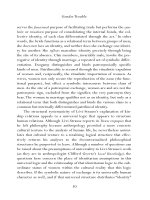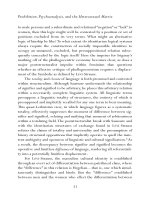GENDER TROUBLE 12
Bạn đang xem bản rút gọn của tài liệu. Xem và tải ngay bản đầy đủ của tài liệu tại đây (18.2 KB, 1 trang )
Preface 1999
summation of a set of political beliefs (sexuality and belief are related in
a much more complex fashion, and very often at odds with one another). Instead, the text asks, how do non-normative sexual practices call
into question the stability of gender as a category of analysis? How do
certain sexual practices compel the question: what is a woman, what is
a man? If gender is no longer to be understood as consolidated through
normative sexuality, then is there a crisis of gender that is specific to
queer contexts?
The idea that sexual practice has the power to destabilize gender
emerged from my reading of Gayle Rubin’s “The Traffic in Women” and
sought to establish that normative sexuality fortifies normative gender.
Briefly, one is a woman, according to this framework, to the extent
that one functions as one within the dominant heterosexual frame and
to call the frame into question is perhaps to lose something of one’s
sense of place in gender. I take it that this is the first formulation of
“gender trouble” in this text. I sought to understand some of the terror
and anxiety that some people suffer in “becoming gay,” the fear of losing one’s place in gender or of not knowing who one will be if one
sleeps with someone of the ostensibly “same” gender.This constitutes a
certain crisis in ontology experienced at the level of both sexuality and
language. This issue has become more acute as we consider various
new forms of gendering that have emerged in light of transgenderism
and transsexuality, lesbian and gay parenting, new butch and femme
identities. When and why, for instance, do some butch lesbians who
become parents become “dads” and others become “moms”?
What about the notion, suggested by Kate Bornstein, that a transsexual cannot be described by the noun of “woman” or “man,” but must
be approached through active verbs that attest to the constant transformation which “is” the new identity or, indeed, the “in-betweenness”
that puts the being of gendered identity into question? Although some
lesbians argue that butches have nothing to do with “being a man,” others insist that their butchness is or was only a route to a desired status
xi









